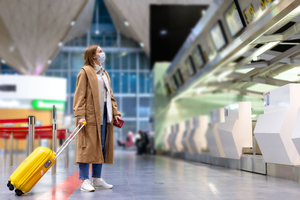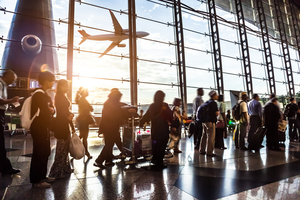 The Coronavirus pandemic has had a dramatic effect on all industries around the world. The impact of COVID-19 has been especially hard on the airport sector as the rapid global spread lead many countries to close down their airports and temporarily ban international flights. Passenger traffic declined, and executives were urged to rethink their business strategies and procedures to lead their business through and after the crisis. New smart technological solutions will be useful in limiting the spread, recovering passenger traffic, and bringing back customer confidence.
The Coronavirus pandemic has had a dramatic effect on all industries around the world. The impact of COVID-19 has been especially hard on the airport sector as the rapid global spread lead many countries to close down their airports and temporarily ban international flights. Passenger traffic declined, and executives were urged to rethink their business strategies and procedures to lead their business through and after the crisis. New smart technological solutions will be useful in limiting the spread, recovering passenger traffic, and bringing back customer confidence.
COVID-19 has increased the awareness of health-related risks associated with traveling. As we move towards the recovery phase, passengers will be more cautious, and their demand for safety measures will be a determining factor to rebuild trust. Airports need to provide solutions and services that adhere to the most rigorous health and safety conditions.
Even before the pandemic, many airlines and airports were planning on implementing major digital transformations. After the hard hit, passengers need to see evidence of actual safety measures and technologies to feel confident about traveling again.
People counters and traffic analytics solutions limit physical contact between people and reduce the chance of any potential  spread of the virus. These technologies include occupancy, heatmap, and queue management solutions, as well as other technologies like thermal imaging cameras, baggage management systems, facial recognition, biometrics, self-check-in, and self-baggage drop.
spread of the virus. These technologies include occupancy, heatmap, and queue management solutions, as well as other technologies like thermal imaging cameras, baggage management systems, facial recognition, biometrics, self-check-in, and self-baggage drop.
The Next Phase
Airports are transforming how they operate to stay competitive and ensure the safety of their passengers and staff. Here’s how:
1. Passenger flow monitoring
Visitor counting and customer behavior analytics solutions allow airports to monitor passenger flow in real-time. These technologies can help airport operators monitor the effects of social distancing and proactively deal with arising issues.
2. Queue Management
Technologies are helping airports implement social distancing through various people counting solutions. Queue Management can keep passengers and operational staff safe by automatizing passenger counting for indoor tracking. Enabling machine learning will provide suggestions to keep the queue times at security checks and check-in counters at a minimum. Pre-booking time slots for airport checkpoints allow passengers to maintain a safe physical distance rather than stand in line. Virtual queuing technologies will prevent passengers from crowding at a single point.
3. Occupancy Control
Passenger occupancy monitoring solutions like VCARE can report people’s numbers on digital screens in real-time, along with safety recommendations displayed to let people know when it’s safe or not safe to enter.
Occupancy also helps with facility management for different zones of the airport. This feature can be utilized to provide periodic sanitization and frequent cleaning for areas with the least traffic.
Showing passengers the commitment to safety measures will be the most crucial requirement for airports as we move forward. V-Count’s solutions can give passengers the peace of mind they need and help airport personnel take proactive actions if required.






